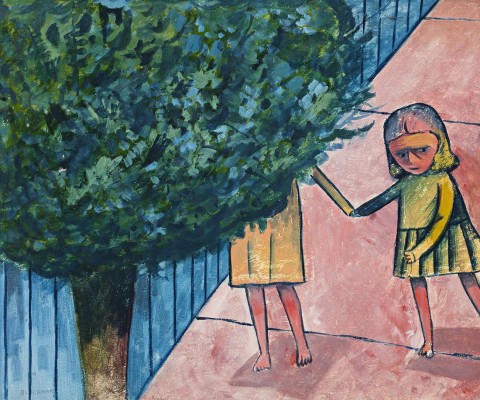THE SISTERS, 1953
CHARLES BLACKMAN
oil on board
62.0 x 74.0 cm
signed and dated lower left:
BLACKMAN / 13, MAY 53
Tolarno Galleries, Melbourne
Savill Galleries, Sydney (label attached verso)
Linton and Kay Galleries, Perth (label attached verso)
Private collection, Perth
Paintings and Drawings: Charles Blackman, Peter Bray Gallery, Melbourne, 12 May 1953, cat. 1
8 Melbourne Painters, Macquarie Galleries, Sydney, 29 July – 10 August 1953, cat. 5
BLACKMAN, Johnstone Gallery, Brisbane, 26 June – 15 July 1960, cat. 9
Charles Blackman, The Schoolgirl Years, Tolarno Galleries, Melbourne, 10 June – 2 July 1988, cat. 15
Charles Blackman, Intimate Reflections, Savill Galleries, Sydney, 13 March – 12 April 1997, cat. 1
(illus. in exhibition catalogue)
‘At Sydney Galleries. 8 Melbourne Painters', Le Courrier Australien, Sydney, 7 August 1953, p. 2
The Exchange, 1952, oil on plywood on composition board, 91.7 x 91.7 cm, in the collection of the National Gallery of Victoria, Melbourne, illus. in Moore, F. St J., Charles Blackman Schoolgirls and Angels, exhibition catalogue, National Gallery of Victoria, Melbourne, 1993, p. 37
The Sisters, 1953 is an important painting from Charles Blackman’s Schoolgirls series, the young artist’s ’first significant sequence of work and the central theme of his inaugural commercial exhibition at Peter Bray Gallery, Melbourne, in May 1953’.1 Listed as number one in the exhibition catalogue, it has rarely been seen in public since. Blackman is on record stating that his painterly visions of anxious and vulnerable schoolgirls were triggered in part by the brutal murder of twelve year-old Alma Tirtschke in a CBD alley in 1922, and by the (still) unsolved murder of a university friend of his wife Barbara, but in many ways The Sisters has a stronger relationship to poetry and to Barbara’s encroaching blindness.
Blackman was born in Sydney where he worked for a while as a cadet cartoonist for The Sun newspaper. Following his marriage to the Brisbane-born Barbara, the family moved into an old coach house and loft in Chrystobel Crescent, Hawthorn, in 1951. Already friendly with the artists Danila Vassilieff, Joy Hester, Laurence Hope and Sidney Nolan, Blackman converted the loft into a studio. On daily walks, he discovered that ‘we were surrounded by thousands and thousands of schools and schoolgirls’2 and soon covered the walls with his paintings and drawings, adding to them every day in a frenzy of work. Bearing distinct linear qualities reminiscent of his previous cartoon work, Blackman also utilised strident colours which matched the mood of the local contemporary art scene still affected by ‘the disturbed years that followed World War II (where) change and disorder were in the artistic air. This was a period in which pastoral harmony and tonal recession were challenged by an expressionism which stirred up the look of things, even seemed to court downright ugliness’.3 Using a similar tactic to other paintings in the series, Blackman upsets the perspective in The Sisters through the use of a sharply angled directional line, seen also in The Crossing, 1952; Schoolgirl at Kooyong, 1953; Prone figure, (1953); and the drawing Schoolgirl and Man, 1952. Set against a ground of acid pink, anxiety pervades the side-long glance of the smaller girl as she leads her companion into the blanket coverage of the tree’s foliage, a possible allusion to Barbara’s blindness and her increased need for protection and physical guidance.
Blackman reproduced stanzas from the poem ‘Schoolgirls Hastening’ by the bush poet John Shaw Neilson in the Peter Bray exhibition catalogue – (t)he schoolgirls hastening through the light – but another Neilson poem, ‘The Orange Tree’, seems a more apt beginning: The young girl stood beside me. I / Saw not what her young eyes could see.4 The exhibition attracted much attention and not a little controversy but, as ever, the Herald’s critic Alan McCulloch proved perceptive arguing that ‘Blackman’s concepts are not painterly, or linear, or tonal, they are psychological … at once exciting and extremely stimulating’.5 Of the extended Schoolgirls series , examples are now housed within major institutional collections including the National Gallery of Australia, Canberra, National Gallery of Victoria, Melbourne and the Art Gallery of New South Wales, Sydney; and in significant corporate collections such as Australian Capital Equity (Kerry Stokes), Wesfarmers, as well as the TarraWarra Museum of Art, Victoria.
1. Morgan, K., ‘Artist’s Biography’, Charles Blackman: Schoolgirls, Heide Museum of Modern Art, Melbourne, 2017, p. 76
2. Shapcott, T., Focus on Charles Blackman, University of Queensland Press, Brisbane, 1967, p. 16
3. Wallace-Crabbe, C., ‘Girls and the City’, in Morgan, K., Charles Blackman: Schoolgirls, Heide Museum of Modern Art, Melbourne, 2017, p. 33
4. Neilson, J.S., ‘The Orange Tree’, cited in Wallace-Crabbe, C., ‘Girls and the City’, op cit., p. 37
5. McCulloch, A., ‘Quantity and quality’, Herald, Melbourne, 12 May 1953, p. 10
ANDREW GAYNOR
